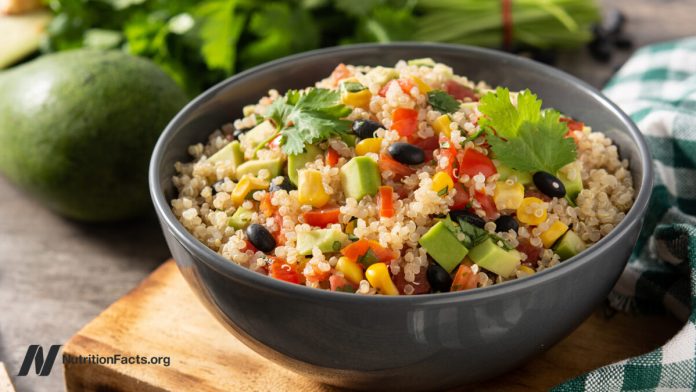How do the nutrition and health effects of quinoa compare to other whole grains?
“Approximately 90% of the world’s calories are provided by less than one percent of the known 250,000 edible plant species.” The big three are wheat, corn, and rice, and our reliance on them may be unsustainable, given the ongoing climate crisis. This has spurred new interest in “underutilized crops,” like quinoa, which might do better with drought and heat.
Quinoa has only recently been introduced into the Northern Hemisphere, but humans have been eating quinoa for more than 7,000 years. Is there any truth to its “superfood” designation, or is it all just marketing hooey?
Quinoa is a “pseudograin,” since the plant it comes from isn’t a type of grass. “Botanically speaking quinoa is an achene, a seed-like fruit with a hard coat,” and it has a lot of vitamins and minerals, but so do all whole grains. It also has a lot of protein. As you can see below and in a series of graphs starting at 1:05 in my video Benefits of Quinoa for Lowering Triglycerides, quinoa has more protein than other grains, but since when do we need more protein? Fiber is what we’re sorely lacking, and its fiber content is relatively modest, compared to barley or rye. Quinoa is pretty strong on folate and vitamin E, though, and it leads the pack on magnesium, iron, and zinc. So, it is nutritious, but when I think superfood, I think of something with some sort of special clinical benefit. Broccoli is a superfood, strawberries are a superfood, and so is garlic, but quinoa? Consumer demand is up, thanks in part to “perceived health benefits,” and it has all sorts of purported benefits in lab animals, but there have been very few human studies.
The first trial was a before-and-after study of quinoa granola bars that showed drops in triglycerides and cholesterol, as you can see below and at 1:53 in my video, but it didn’t have a control group, so we don’t know how much of that would have happened without the quinoa. The kind of study I want to see is a randomized controlled trial. When researchers gave participants about a cup of cooked quinoa every day for 12 weeks, they experienced a 36 percent drop in their triglycerides. That’s comparable to what one gets with triglyceride-lowering drugs or high-dose fish oil supplements.
Which is better, regular quinoa or red quinoa? As you can see in the graph below and at 2:22 in my video, the red variety has about twice the antioxidant power, leading the investigators to conclude that red quinoa “might…contribute significantly to the management and/or prevention of degenerative diseases associated with free radical damage,” but it’s never been put to the test.
What about black quinoa? Both red and black quinoa appear to be equally antioxidant-rich, both beating out the more conventional white variety, as you can see in the graph below and at 2:46 in my video.
The only caveat I could find is to inform your doctor before your next colonoscopy or else they might mistake quinoa for parasites. As reported in a paper, a “colonoscopy revealed numerous egg-like tan-yellow ovoid objects, 2 to 3 mm in diameter, of unclear cause,” but they were just undigested quinoa.
For more on the superfoods I mentioned, check the related posts below.
Isn’t fish oil important to heart health? Find out in my video Is Fish Oil Just Snake Oil?.






